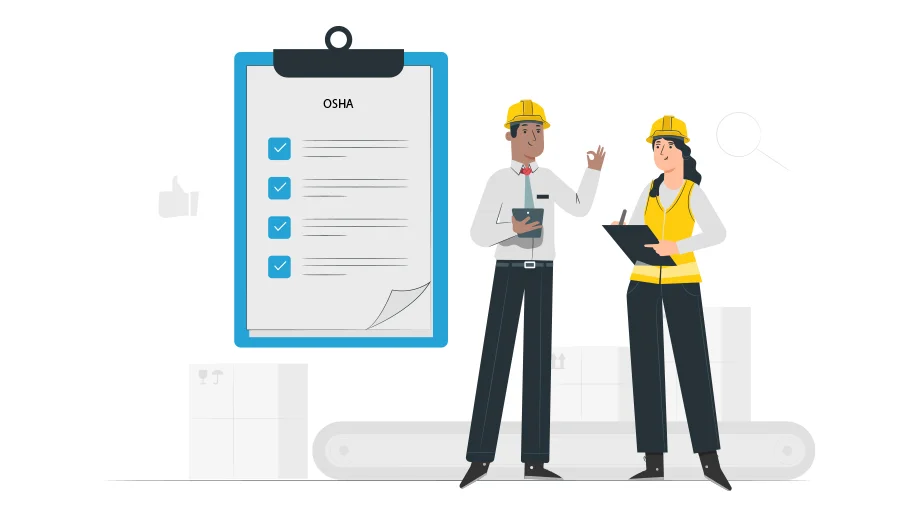Do your field technicians use safety gear? Look beyond the basics like hard hats and orange vests. Personal Protective Equipment (PPE) encompasses various items such as gloves, eye protection, ear protection, sturdy boots, and respiratory masks. According to OSHA compliance regulations, employers are legally obligated to furnish this equipment to their employees, provide training on its proper use, and replace any damaged or worn-out gear.
Occupational Safety and Health Administration (OSHA) has specific regulations regarding working alone to ensure the safety and health of workers. The OSHA compliance regulations on working alone, also known as the “Lone Worker Policy”, are designed to address the unique hazards faced by employees who work alone or without direct supervision.
Among the myriad of regulation requirements, as a field manager you may find yourself wondering- What is OSHA compliance? In this blog, we will simplify the OSHA compliance checklist and what you must know to remain OSHA compliant.

According to OSHA, employers have a responsibility to provide a safe workplace for all employees, including those who work alone. OSHA prohibits working alone in certain hazardous situations, such as confined spaces, but there is no general prohibition on working alone.
However, employers are required to conduct a hazard assessment to identify potential hazards for lone workers. This will help them to develop appropriate control measures and mitigate those hazards.
Employers should implement a comprehensive lone worker policy that outlines procedures for checking on the safety of field and lone workers. This will further include communicating with them, and responding to emergencies. The policy should also include safety training for employees and provide them with the necessary personal protective equipment.
Apart from OSHA, some States also enforce their unique standards for a safe work environment. Workplace safety is crucial, but complying with standards and regulations has challenged employers since their enactment.
What Challenges Do Businesses Face While Maintaining OSHA Compliance?
Employers struggle with the tedious tasks required in meeting field worker compliance standards. Constantly maintaining communication with employees to monitor changing conditions and collect safety updates can be a time-consuming task for both employers and employees. Whether it’s to meet lone worker safety requirements or to check work conditions for weather-related field worker requirements.
Frequent monitoring of multiple off-site working conditions can divert employers and managers’ attention from unexpected on-site crises and non-job-related tasks. Simultaneously, worrying about worker safety and OSHA compliance can deplete resources and decrease productivity for employers and employees.
How Can Automation Help in Adhering To OSHA Compliance?
With advanced mobile applications, you can automate daily field service tasks and increase productivity. These apps can improve communication between workers and managers, streamline data collection, and simplify task tracking and scheduling.
They further include GPS tracking, allowing employers to monitor employee locations and respond to emergencies quickly. They can also help with inventory management, route optimization, and job completion tracking.
With pre-set alerts, in-app messages, and real-time location tracking, employers can ensure that their workers are safe and productive while in the field. This automation will noticeably simplify the process of adhering to OSHA and state rules.
Mobile workforce management apps with specialized field and lone worker capabilities can provide a variety of functions that help your business with compliance. They can send alerts throughout the day reminding employees to take mandatory breaks.
In the hotter months, some states offer stricter guidelines for heat-related working conditions. These regulations require greater contact and communication that employers can streamline through in-app abilities.
For example, based on California law, field workers must take a mandatory break totalling 10 minutes within the two hours that the temperature reaches 95 degrees. When the temperature threshold is passed, an automated alert can be sent to employee phones informing them that they need to take their required breaks.
Conclusion
OSHA compliance includes specific laws and regulations related to working alone. Employers are responsible for identifying potential hazards and developing policies and procedures to mitigate those hazards. By implementing a comprehensive lone worker policy, employers can ensure the safety and health of their employees who work alone.
A lone worker policy will do little without tools that can help you take action in situations of emergency. By adopting a lone worker safety app, you will be able to
If you are still wondering what is OSHA compliance, the penalties for violation and a comprehensive OSHA compliance checklist.


